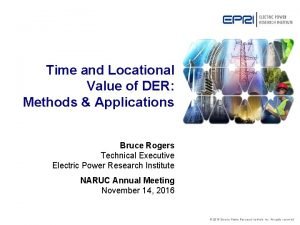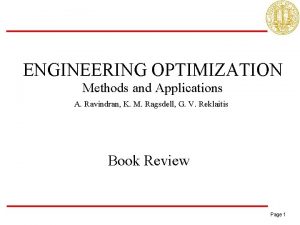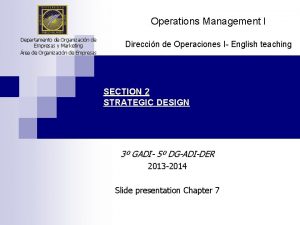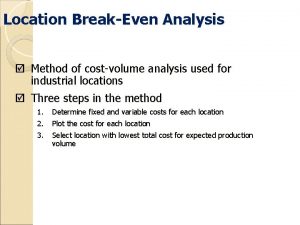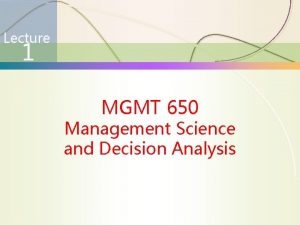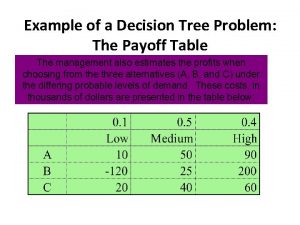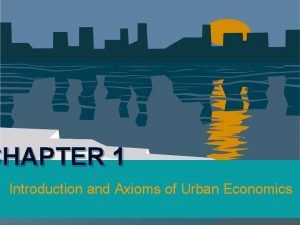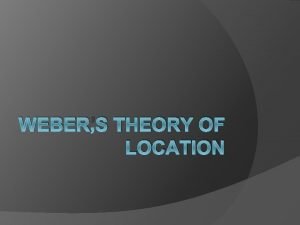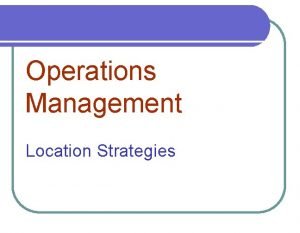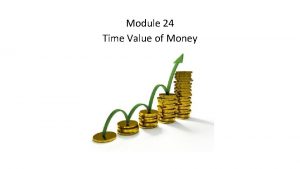Time and Locational Value of DER Methods Applications





















- Slides: 21

Time and Locational Value of DER: Methods & Applications Bruce Rogers Technical Executive Electric Power Research Institute NARUC Annual Meeting November 14, 2016 © 2016 Electric Power Research Institute, Inc. All rights reserved.

DER Proceedings are Proliferating in More Than 20 States 2 © 2016 Electric Power Research Institute, Inc. All rights reserved.

California and New York Taking Progressive Actions “The IOUs are required to define locational benefits and optimal locations for DER moving the IOUs towards a more full integration of DER into their distribution system planning, operations and investment. – CA PUC Code 769, Aug 2014 3 “The more efficient system will be designed and operated to make optimal use of cleaner and more efficient generation technologies and will encourage substantial increases in deployment of these technologies. . . DER will become integral tools in the planning, management and operation of the electric system. – NY REV, Feb 2015 © 2016 Electric Power Research Institute, Inc. All rights reserved.

EPRI’s Study: Time and Locational Value of DER § Modeled Actual Systems – Con Edison Mesh Network and Southern California Edison Flexible Radial – Studied 10 -year planning timeframe – Companion study by Sue Tierney, The Analysis Group § Two DER Interconnection Scenarios – DER only to meet all load growth – DER at customer discretion § Used EPRI’s Benefit-Cost Framework – Objective, reproducible, transparent – Assesses impacts of interconnected DER – Estimates value/cost to society Asks whether DER can economically replace or avoid investments otherwise needed to accommodate growth 4 © 2016 Electric Power Research Institute, Inc. All rights reserved.

The Systems: Mesh Network and Flexible Radial Topologies Mesh Network System (Con Edison) Flexible Radial System (SCE) Two very different systems demonstrate the methodology. 5 © 2016 Electric Power Research Institute, Inc. All rights reserved.

EPRI’s Integrated Grid Benefit Cost Framework Distribution System Hosting Energy Capacity Reliability Benefit-Cost Scenario Definition Market Conditions DER Adoption System Assumptions System Cost Changes Bulk System Resource Adequacy Transmission Performance Flexibility Transmission Expansion Societal Costs/Benefits Customer or Owner Cost/Benefits Operational Practices & Simulation Study focuses on the elements of the distribution system. 6 © 2016 Electric Power Research Institute, Inc. All rights reserved.

System studies reveal the time and duration of system needs Peak day load shape reveals time and duration of need System annual load shape reveals peak day Power flow studies reveal the time and size of needed upgrades Traditional utility equipment or DER must be available, dependable, and durable. 7 © 2016 Electric Power Research Institute, Inc. All rights reserved.

Concept: Deferral of Distribution Upgrades with DER Traditional Approach k. W Capacity Expansion Current Capacity Current Demand 1 12 Forecasted Demand 24 Hours Expand infrastructure to keep up with load growth 8 © 2016 Electric Power Research Institute, Inc. All rights reserved.

Concept: Deferral of Distribution Upgrades with DER Thousands of customer-sited solutions k. W DER Portfolio Approach Capacity Expansion Current Capacity Current Demand 1 12 Forecasted Demand 24 Hours A portfolio of DER technologies needed to shave peak. Peak load duration matters. 9 © 2016 Electric Power Research Institute, Inc. All rights reserved.

DER portfolio assembled based on technology, customer, and system load-curve characteristics Technology/ Market Potential Availability Factor Con Edison Study Portfolio Capacity Coincidence SCE Study Portfolio It takes a portfolio of DER to meet system and customer needs and to defer traditional assets cost-effectively. 10 © 2016 Electric Power Research Institute, Inc. All rights reserved.

Modeling reveals locational sensitivity in the local distribution system Locational Overloaded Transformer ∆Flow Sensitivity Neighboring transformer Distance A DER energy disperses from points A, B and C C B Network System: Multi-directional Power Flows Neighboring transformer In a network, the effectiveness of DER degrades with distance from the overload. 11 © 2016 Electric Power Research Institute, Inc. All rights reserved.

Modeling reveals locational sensitivity in the local distribution system Transformer Overload – 63 k. VA 153 k. W of DER needed if optimally located Neighboring transformer 340 k. W of DER needed with 10 k. W limitation Network System: Multi-directional Power Flows Neighboring transformer DER location In a network, DER must be tightly situated near the distribution violation to be cost effective. 12 © 2016 Electric Power Research Institute, Inc. All rights reserved.

Modeling reveals locational sensitivity in the local distribution system DER energy directly reduces transformer flow whether at A, B, or C. Overloaded Transformer A B Simple Radial System: Unidirectional Power Flows C In radial systems, DER located downstream from a capacity constraint can contribute directly to relieving it. 13 © 2016 Electric Power Research Institute, Inc. All rights reserved.

Modeling reveals locational sensitivity in the local distribution system Overloaded Transformer B A Flexible Radial System: Multi-directional Power Flows C Overloaded Transformer Neighboring transformer B A Ope n Close d 50% more DER needed to provide the same capacity relief in both configurations C Neighboring transformer Reconfiguration provides operational flexibility and is a desirable feature of radial system design. 14 © 2016 Electric Power Research Institute, Inc. All rights reserved.

Economic Evaluation of Alternative Upgrade Plans Modeling Assumptions and Outputs Bulk-system characteristics LMP & Carbon cost rates Capacity cost rates Distribution-system/feeder Energy growth Load shape One of: 10 -year distribution upgrade plans to satisfy voltage, capacity, and protection constraints 10 -year DER plans to satisfy voltage, capacity, and protection constraints Economic Analysis Outputs Cost of serving load growth: • Energy cost (load/losses) • Capacity cost • Carbon cost Load Cost ($/k. Whgrth) Cost of distribution upgrades: • Asset ownership costs (revenue requirements) • O&M costs Cost and value of DER: • Equipment cost (Utility procurement) • Net energy value • Loss-reduction value • Carbon-reduction value • Avoided capacity value Accommodation ($/k. Whgrth) Incremental Cost to Serve Growth in Load ($/k. Whgrth) In this study we estimated the cost to serve load growth. 15 © 2016 Electric Power Research Institute, Inc. All rights reserved.

Example Waterfall Chart - Comparison of Costs for Con Edison Case Study w/No Headroom Cost to Meet Load Growth – Traditional Utility Solution Cost to Meet Load Growth – DER Solution No Headroom DER solution net cost is slightly higher than traditional solution, but leaves the circuit with no headroom. 16 © 2016 Electric Power Research Institute, Inc. All rights reserved.

Summary of Economic Results from Case Studies Con Edison Economic Results Summary SCE Economic Results Summary Studies illustrate the complexity of incorporating DER into the distribution planning process. 17 © 2016 Electric Power Research Institute, Inc. All rights reserved.

Conclusions from Study § Comprehensive, objective, and transparent methods are required for consistent and sensible results. § It takes a portfolio of DER to meet system and customer needs and defer traditional assets costeffectively. § It is hard to generalize the net benefits of DER as an alternative to conventional grid investments. § Time and locational impacts are key determinants in valuing DER. 18 © 2016 Electric Power Research Institute, Inc. All rights reserved.

What Is Still Needed? § Planning processes and tools must transition to fully incorporate DER and their potential value. § Detailed engineering studies needed to capture the important nuances in how DER can be accommodated. §Grid modernization will also be a critical to sustain the safety and reliability of the distribution system, minimize overall system cost, and maximize benefits from DER. 19 © 2016 Electric Power Research Institute, Inc. All rights reserved.

Case Study Team § Con Edison: Matt Ketschke, Steve Wemple, Tom Mimnagh, Candice Tsay, Raghu Sudhakara, David Wang, Damian Sciano, Stuart Nachmias and others § SCE: Erik Takayesu, Caroline Choi, Heather Sanders, Dhaval, Dagli, Jeff Nelson, Mark Nelson, Robert Sherick and others § EPRI: Mark Mc. Granaghan, Jeffrey Roark, Bernie Neenan, Jason Taylor, Jeff Smith, Tom Short, Roger Dugan, Bruce Rogers and others § Analysis Group: Susan Tierney 20 © 2016 Electric Power Research Institute, Inc. All rights reserved.

Together…Shaping the Future of Electricity For more information contact: Bruce Rogers, brogers@epri. com or Deana Dennis, ddennis@epri. com Time and Locational Value of DER: Methods and Applications (3002008410) 21 © 2016 Electric Power Research Institute, Inc. All rights reserved.
 Locational value
Locational value Value creation value delivery value capture
Value creation value delivery value capture Balaraman ravindran
Balaraman ravindran Locational break even analysis
Locational break even analysis Location break even analysis
Location break even analysis Locational break even analysis
Locational break even analysis Locational break even analysis
Locational break even analysis Types of facility location
Types of facility location Locational break even analysis
Locational break even analysis Locational equilibrium
Locational equilibrium Prorupted state ap human geography
Prorupted state ap human geography Interest rate parity example
Interest rate parity example International arbitrage example
International arbitrage example Marketing
Marketing Isodapane in the theory of industrial location
Isodapane in the theory of industrial location Crossover chart operations management
Crossover chart operations management Location cost volume analysis example
Location cost volume analysis example What is international arbitrage
What is international arbitrage Locational break even analysis
Locational break even analysis Locational excellence companies
Locational excellence companies International arbitrage and interest rate parity
International arbitrage and interest rate parity For minutes. start.
For minutes. start.
